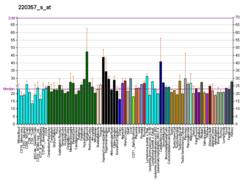SGK2
| SGK2 | |||||||||||||||||||||||||||||||||||||||||||||||||||
|---|---|---|---|---|---|---|---|---|---|---|---|---|---|---|---|---|---|---|---|---|---|---|---|---|---|---|---|---|---|---|---|---|---|---|---|---|---|---|---|---|---|---|---|---|---|---|---|---|---|---|---|
| Identifiers | |||||||||||||||||||||||||||||||||||||||||||||||||||
| Aliases | SGK2, H-dJ138B7.2, serine/threonine kinase 2, serum/glucocorticoid regulated kinase 2 | ||||||||||||||||||||||||||||||||||||||||||||||||||
| External IDs | OMIM: 607589; MGI: 1351318; HomoloGene: 8446; GeneCards: SGK2; OMA:SGK2 - orthologs | ||||||||||||||||||||||||||||||||||||||||||||||||||
| |||||||||||||||||||||||||||||||||||||||||||||||||||
| |||||||||||||||||||||||||||||||||||||||||||||||||||
| |||||||||||||||||||||||||||||||||||||||||||||||||||
| |||||||||||||||||||||||||||||||||||||||||||||||||||
| |||||||||||||||||||||||||||||||||||||||||||||||||||
| Wikidata | |||||||||||||||||||||||||||||||||||||||||||||||||||
| |||||||||||||||||||||||||||||||||||||||||||||||||||
Serine/threonine-protein kinase Sgk2 is an enzyme that in humans is encoded by the SGK2 gene.[5][6]
This gene encodes a serine/threonine protein kinase. Although this gene product is similar to serum- and glucocorticoid-induced protein kinase (SGK), this gene is not induced by serum or glucocorticoids. This gene is induced in response to signals that activate phosphatidylinositol 3-kinase (PI3K), which is also true for SGK. Two alternate transcripts encoding two different isoforms have been described.[6]
References
- ^ a b c GRCh38: Ensembl release 89: ENSG00000101049 – Ensembl, May 2017
- ^ a b c GRCm38: Ensembl release 89: ENSMUSG00000017868 – Ensembl, May 2017
- ^ "Human PubMed Reference:". National Center for Biotechnology Information, U.S. National Library of Medicine.
- ^ "Mouse PubMed Reference:". National Center for Biotechnology Information, U.S. National Library of Medicine.
- ^ Kobayashi T, Deak M, Morrice N, Cohen P (Jan 2000). "Characterization of the structure and regulation of two novel isoforms of serum- and glucocorticoid-induced protein kinase". Biochem J. 344 (1): 189–97. doi:10.1042/0264-6021:3440189. PMC 1220630. PMID 10548550.
- ^ a b "Entrez Gene: SGK2 serum/glucocorticoid regulated kinase 2".
Further reading
- Lang F, Cohen P (2002). "Regulation and physiological roles of serum- and glucocorticoid-induced protein kinase isoforms". Sci. STKE. 2001 (108): RE17. doi:10.1126/stke.2001.108.re17. PMID 11707620. S2CID 25927734.
- Deloukas P, Matthews LH, Ashurst J, et al. (2002). "The DNA sequence and comparative analysis of human chromosome 20". Nature. 414 (6866): 865–71. Bibcode:2001Natur.414..865D. doi:10.1038/414865a. PMID 11780052.
- Gamper N, Fillon S, Feng Y, et al. (2003). "K+ channel activation by all three isoforms of serum- and glucocorticoid-dependent protein kinase SGK". Pflügers Arch. 445 (1): 60–6. doi:10.1007/s00424-002-0873-2. PMID 12397388. S2CID 21073737.
- Strausberg RL, Feingold EA, Grouse LH, et al. (2003). "Generation and initial analysis of more than 15,000 full-length human and mouse cDNA sequences". Proc. Natl. Acad. Sci. U.S.A. 99 (26): 16899–903. Bibcode:2002PNAS...9916899M. doi:10.1073/pnas.242603899. PMC 139241. PMID 12477932.
- Friedrich B, Feng Y, Cohen P, et al. (2003). "The serine/threonine kinases SGK2 and SGK3 are potent stimulators of the epithelial Na+ channel alpha,beta,gamma-ENaC". Pflügers Arch. 445 (6): 693–6. doi:10.1007/s00424-002-0993-8. PMID 12632189. S2CID 32511608.
- Embark HM, Böhmer C, Vallon V, et al. (2003). "Regulation of KCNE1-dependent K(+) current by the serum and glucocorticoid-inducible kinase (SGK) isoforms". Pflügers Arch. 445 (5): 601–6. doi:10.1007/s00424-002-0982-y. PMID 12634932. S2CID 22981271.
- Gerhard DS, Wagner L, Feingold EA, et al. (2004). "The status, quality, and expansion of the NIH full-length cDNA project: the Mammalian Gene Collection (MGC)". Genome Res. 14 (10B): 2121–7. doi:10.1101/gr.2596504. PMC 528928. PMID 15489334.
- Baltaev R, Strutz-Seebohm N, Korniychuk G, et al. (2005). "Regulation of cardiac shal-related potassium channel Kv 4.3 by serum- and glucocorticoid-inducible kinase isoforms in Xenopus oocytes". Pflügers Arch. 450 (1): 26–33. doi:10.1007/s00424-004-1369-z. PMID 15578212. S2CID 190895.
- Cheng J, Kapranov P, Drenkow J, et al. (2005). "Transcriptional maps of 10 human chromosomes at 5-nucleotide resolution". Science. 308 (5725): 1149–54. Bibcode:2005Sci...308.1149C. doi:10.1126/science.1108625. PMID 15790807. S2CID 13047538.
External links
- SGK2 human gene location in the UCSC Genome Browser.
- SGK2 human gene details in the UCSC Genome Browser.
- v
- t
- e
Serine/threonine-specific protein kinases (EC 2.7.11.21-EC 2.7.11.30) | |||||||||||||||||||||
|---|---|---|---|---|---|---|---|---|---|---|---|---|---|---|---|---|---|---|---|---|---|
| |||||||||||||||||||||
Dual-specificity kinases (EC 2.7.12) | |||
|---|---|---|---|
| |||
 | This article on a gene on human chromosome 20 is a stub. You can help Wikipedia by expanding it. |
- v
- t
- e




















